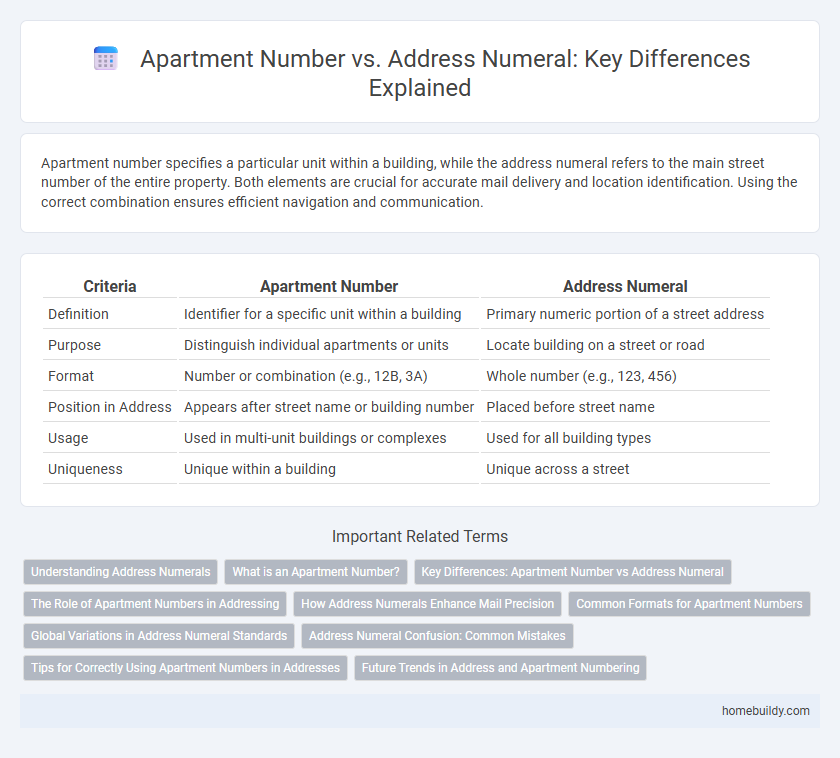Apartment number specifies a particular unit within a building, while the address numeral refers to the main street number of the entire property. Both elements are crucial for accurate mail delivery and location identification. Using the correct combination ensures efficient navigation and communication.
Table of Comparison
| Criteria | Apartment Number | Address Numeral |
|---|---|---|
| Definition | Identifier for a specific unit within a building | Primary numeric portion of a street address |
| Purpose | Distinguish individual apartments or units | Locate building on a street or road |
| Format | Number or combination (e.g., 12B, 3A) | Whole number (e.g., 123, 456) |
| Position in Address | Appears after street name or building number | Placed before street name |
| Usage | Used in multi-unit buildings or complexes | Used for all building types |
| Uniqueness | Unique within a building | Unique across a street |
Understanding Address Numerals
Address numerals serve as vital identifiers in mailing systems, distinguishing properties within a street or complex. An apartment number specifically denotes a unit within a larger building, while the address numeral refers to the main property number assigned to the building itself. Proper understanding of address numerals ensures accurate location identification and efficient navigation for delivery, emergency response, and postal services.
What is an Apartment Number?
An apartment number is a specific identifier assigned to a unit within a larger residential building, distinguishing individual living spaces from one another. This number helps postal services, emergency responders, and visitors locate the exact apartment inside a complex. Address numerals typically refer to the primary building number on a street, while the apartment number provides a secondary, crucial detail for precise navigation within that address.
Key Differences: Apartment Number vs Address Numeral
Apartment numbers specifically identify individual units within multi-unit residential buildings, streamlining mail delivery and navigation in complexes. Address numerals serve as the primary numerical designation of a building on a street, essential for location identification in urban planning and emergency services. The key difference lies in scope: address numerals pinpoint a building's external location, while apartment numbers specify interior subdivisions within that building.
The Role of Apartment Numbers in Addressing
Apartment numbers play a crucial role in precisely identifying individual units within multi-unit buildings, enhancing mail delivery and emergency response efficiency. Unlike general address numerals that denote street location, apartment numbers specify the exact living space, preventing confusion in dense urban environments. This specificity contributes to organized urban planning and facilitates navigation within complex residential structures.
How Address Numerals Enhance Mail Precision
Address numerals play a crucial role in enhancing mail precision by clearly distinguishing individual units within multi-unit buildings, such as apartments. Unlike generic apartment numbers, prominently displayed address numerals ensure quick visual identification by mail carriers, reducing delivery errors and delays. This system directly improves the efficiency of mail sorting and accurate package placement, especially in dense urban areas with complex addressing schemes.
Common Formats for Apartment Numbers
Apartment numbers typically appear in formats such as #12, Apt. 12, or Unit 12 within an address numeral, helping to specify individual units in multi-residence buildings. Commonly, the apartment number follows the street address and is separated by a comma or a space, for example, 123 Main St, Apt. 12. These formats ensure clarity in mail delivery and navigation systems by distinctly identifying the precise location inside a larger address.
Global Variations in Address Numeral Standards
Apartment numbers and address numerals vary significantly across global addressing systems, reflecting diverse cultural and administrative norms. In some countries, such as Japan and South Korea, address numerals emphasize block and building sequences rather than street numbers, while Western countries typically use street-based numerals combined with apartment identifiers. Understanding these variations is essential for accurate geolocation, postal services, and urban planning in multinational contexts.
Address Numeral Confusion: Common Mistakes
Mistakes with address numerals often stem from confusing apartment numbers with the main address number, leading to misdelivery or navigation errors. Address numerals must be clearly distinguished from apartment numbers by separating building numbers (e.g., 123) and unit identifiers (e.g., Apt 4B) to ensure accurate location identification. Incorrect formatting or omission of either element causes common confusion in postal and emergency services.
Tips for Correctly Using Apartment Numbers in Addresses
Apartment numbers should be clearly indicated following the street address to ensure accurate mail delivery and location identification. Use standard abbreviations such as "Apt" or "#" directly before the number, for example, "123 Main St Apt 4B," to maintain consistency and clarity. Avoid placing the apartment number on a separate line or omitting it, as this can cause confusion or delays in sorting and delivery processes.
Future Trends in Address and Apartment Numbering
Future trends in address and apartment numbering emphasize integrating smart technology with geospatial data to enhance accuracy and navigation. Digital address systems and blockchain-based verification are emerging to ensure secure, immutable property identification. Increased urban density drives the adoption of dynamic, multi-layered numeration schemes to accommodate complex residential layouts efficiently.
Apartment number vs Address numeral Infographic

 homebuildy.com
homebuildy.com